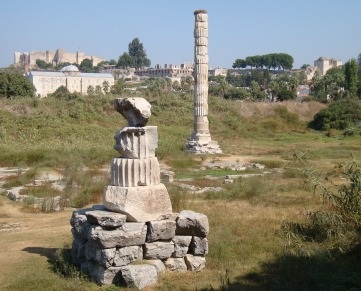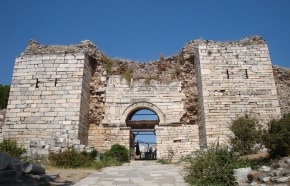Best base for visiting Ephesus Population: 32,200
Old/other names: Agios Theologos, Apasa, Efes, Ayasuluğ/Ayasoluk
Market day: Saturday
Surrounded by orchards, the pretty small town of Selçuk makes a much nicer base than better-known Kuşadası for independent travellers intent on visiting Ephesus, Turkey’s biggest and best-known archaeological site (at least in my opinion). But Selçuk’s proximity to Ephesus is both its strength and its weakness: its strength because it ensures that plenty of visitors come here who probably wouldn’t otherwise; its weakness because they mostly come with thoughts only of the great Roman theatre, the wonderful Terraced Houses with their frescoes and mosaics, and the famous communal toilets of what was once Asia Minor’s capital city.
Those who linger, however, are usually thrilled to discover that Selçuk is a wonderful place in its own right, with plenty to see not only in the town itself but also in the surrounding area.

Backstory
The first settlement in this area appears to have been on what is now Ayasuluk Hill in the centre of town where Hittite remains have been excavated. However, it was the new settlement at Ephesus that eventually grabbed the limelight as it grew into the wealthy capital of Roman Asia Minor.
In the fifth century, as Ephesus’ port started to silt up, a new settlement started to develop around the site of the great Temple of Artemis, one of the Seven Wonders of the Ancient World.
Eventually, though, development returned to the area around Ayasuluk. The new town at the foot of the hill went on to flourish under the Aydınoğlus, a local dynasty that rose to supremacy in the power-vacuum left after the collapse of the Selçuk Sultanate of Rum.
Around town
 The Ephesus Museum (open every day) houses some of the most important finds from the archaeological site, including statues of the Mother Goddess Kybele which show her garlanded with what look like multiple breasts but which scholars assure us are actually the severed testicles of her followers. For those whose imaginations struggle with the bare bones of archaeological sites, the museum also contains a reconstruction of the interior of one of the Terraced Houses as it might have looked in its heyday.
The Ephesus Museum (open every day) houses some of the most important finds from the archaeological site, including statues of the Mother Goddess Kybele which show her garlanded with what look like multiple breasts but which scholars assure us are actually the severed testicles of her followers. For those whose imaginations struggle with the bare bones of archaeological sites, the museum also contains a reconstruction of the interior of one of the Terraced Houses as it might have looked in its heyday.
Selçuk’s other historical monuments are mainly clustered to the north and west of the museum. Most prominent are the remains of the Basilica of St John who was buried on Ayasuluk Hill close to the site where he had written a gospel recording details of the life of Jesus. The site is entered via the imposing Gate of Persecution, which once carried an image of Achilles mistakenly believed to show a gladiator fighting in the Ephesus amphitheatre.
The site is entered via the imposing Gate of Persecution, which once carried an image of Achilles mistakenly believed to show a gladiator fighting in the Ephesus amphitheatre.
The Emperor Justinian had two small churches here merged into one more appropriately magnificent basilica which was extremely popular with medieval pilgrims until 1402 when Tamerlane and the Mongols rampaged through and destroyed it. Just enough excavation and restoration has been carried out to give some idea of the size and splendour of the building. The site of St John’s tomb is marked by a simple slab.

From the site of the basilica you can gaze up at the restored walls of Selçuk Kalesi (Castle) which crown the hill and date back to 6th century. Tucked inside the walls are the remains of a Beylik-era mosque, a palace probably designed by the same man who dreamt up the İsa Bey Cami and a small basilican chapel that was later used as a cistern. The views from the ramparts are spectacular.
The basilica aside, Selçuk’s other truly magnificent attraction is the İsa Bey Cami, a huge mosque with two truncated minarets and an exceptionally large courtyard where the congregation once worshipped out of doors. It was built in 1375 for the Aydınoğlu emir İsa Bey, a bust of whom stands just across the street.

The mosque may be ruinous now but it’s regarded as one of the finest examples of a style marking the transition from Selçuk to Ottoman architecture, with elaborate decoration of the doors and windows and the earliest example of the sort of large courtyard that would become standard in later Ottoman architecture.
Dotted around town are several other minor Selçuk/Aydınoğlu tombs and mosques.
Harder to miss is an extremely conspicuous Byzantine aqueduct that runs right through the main square and out past the railway station to the east. Every spring storks returning from their migration to Africa resettle on the exact same nests they used in previous years, staying put, with a lot of clattering of beaks and general busy baby-rearing, until late August when they retreat to Africa again.
Also in the main square stands a marvellous but little mentioned monument to the Turkish War of Independence (1919-22) by the Turkish sculptor Mehmet Aksoy, sometimes rather fancifully called ‘the Anatolian Michelangelo’. In a country where public monuments often seem somewhat childish, this is a remarkable piece of sculpture, featuring Aksoy’s trademark mixing of stone and metal, and creation of evocative inside-out images. The middle of the monument has been hollowed out so that people can walk through it, stumbling on the uneven floor and perhaps getting some tiny sense of what it might have been like to fight in the trenches.
The Bellek Müzesi (Collective Memories Museum) is housed in the sturdy old town-centre Customs House. Potentially very interesting, it was only labelled in Turkish when I visited which limits its usefulness to foreign visitors. The upper floor has lots of information about the origins of the many immigrants to the area.
 As you head out towards Pamucak beach, you will come to a road junction with, immediately to the north-west, what looks like a tramshed but is in fact the Çetin Kültür Köyü Müzesi, with hundreds of tiny models of traditional Anatolian life, the handiwork of Ayhan and Nazmiye Çetin. For parents pressed to find non-historical attractions to amuse their children, this is likely to prove a godsend.
As you head out towards Pamucak beach, you will come to a road junction with, immediately to the north-west, what looks like a tramshed but is in fact the Çetin Kültür Köyü Müzesi, with hundreds of tiny models of traditional Anatolian life, the handiwork of Ayhan and Nazmiye Çetin. For parents pressed to find non-historical attractions to amuse their children, this is likely to prove a godsend.
Eating
Selçuk is not one of Turkey’s fine dining centres. Most of the pensions provide their own meals as do some of the better hotels, leaving thin pickings for the stand-alone restaurants in the town centre.
One of the more inviting places to eat is the Eski Ev (Old House) Restaurant where tables fill a small greenery-festooned courtyard in summer. Prices are reasonable for what’s on offer and the food’s not at all bad either with a choice of Turkish staples and international favourites like chicken schitznel.
Sleeping
Selçuk has accommodation to suit all budgets. Most of it used to be aimed at backpackers but it also has a few more upmarket places.
Kiwi Pension. Tel: 0232-892 4892
Nilya Hotel. Tel: 0232-892 9081
Transport info
Selçuk is a short bus or train ride from İzmir airport. There are also regular dolmuşes from Kuşadası.
In the town-centre otogar you can pick up hourly dolmuşes to Şirince and to Söke for onward connections.
If you want to visit Meryemana you may need to take a taxi or go on a tour that includes it. Tours are also available to the ruins at Priene, Miletus and Didyma (PMD). Miletus in particular is hard to visit under your own steam although a new bus service from Söke has improved things since 2015.
It’s an easy 2km walk to the southern entrance of Ephesus along a eucalyptus-shaded path. A regular dolmuş also runs to the southern entrance. If you don’t want to have to double-back on yourself, get a taxi to the northern entrance, walk down through the ruins, then catch the dolmuş back at the end. If you ask a taxi driver they will take you to the Cave of the Seven Sleepers on the way to the ruins.
Day trip destinations


